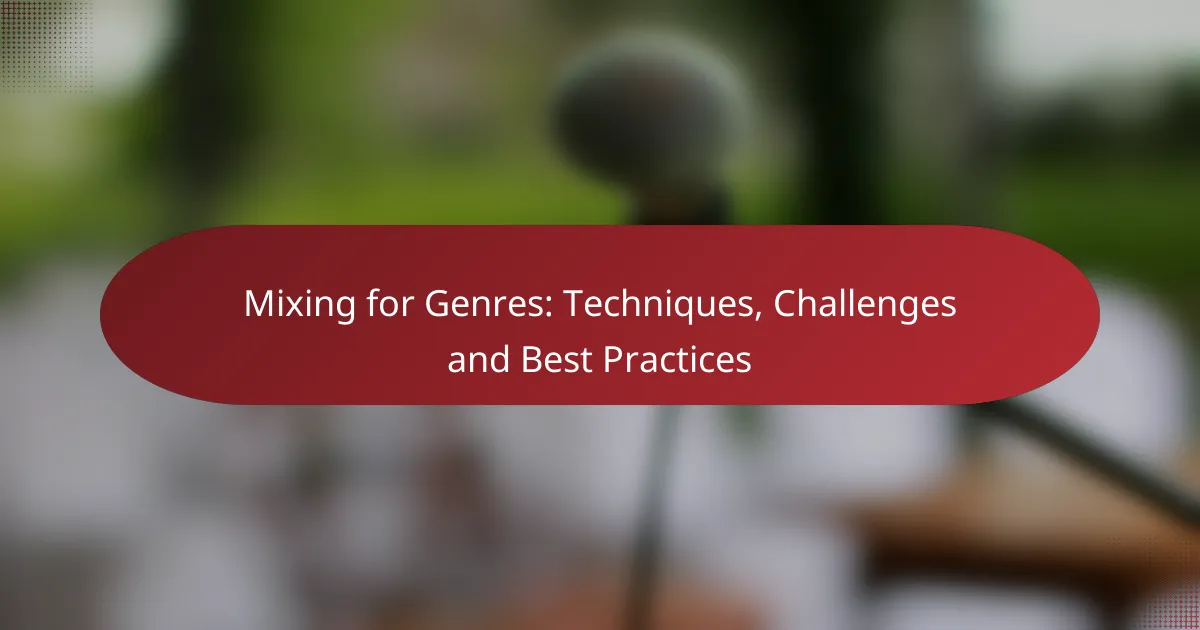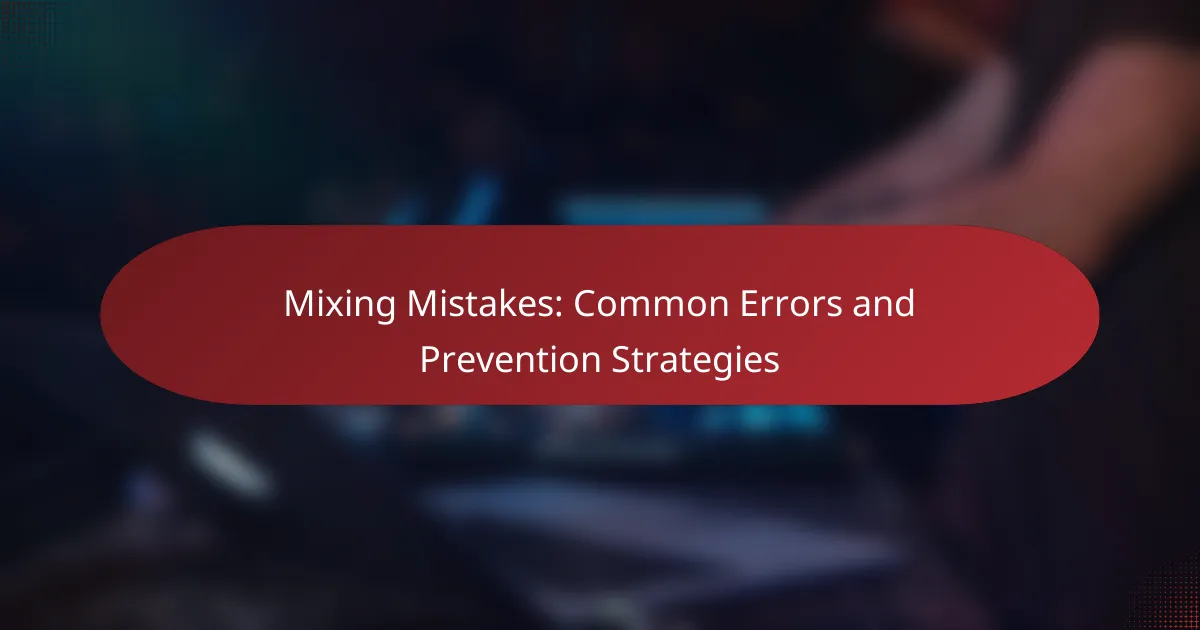Mixing for different music genres requires a nuanced understanding of specific techniques and challenges unique to each style. By employing methods such as layering instruments and applying tailored EQ settings, producers can create mixes that not only respect the essence of the genre but also maintain clarity and balance. Additionally, the use of digital tools facilitates creative exploration, enabling artists to seamlessly blend diverse sounds and push the boundaries of traditional mixing practices.
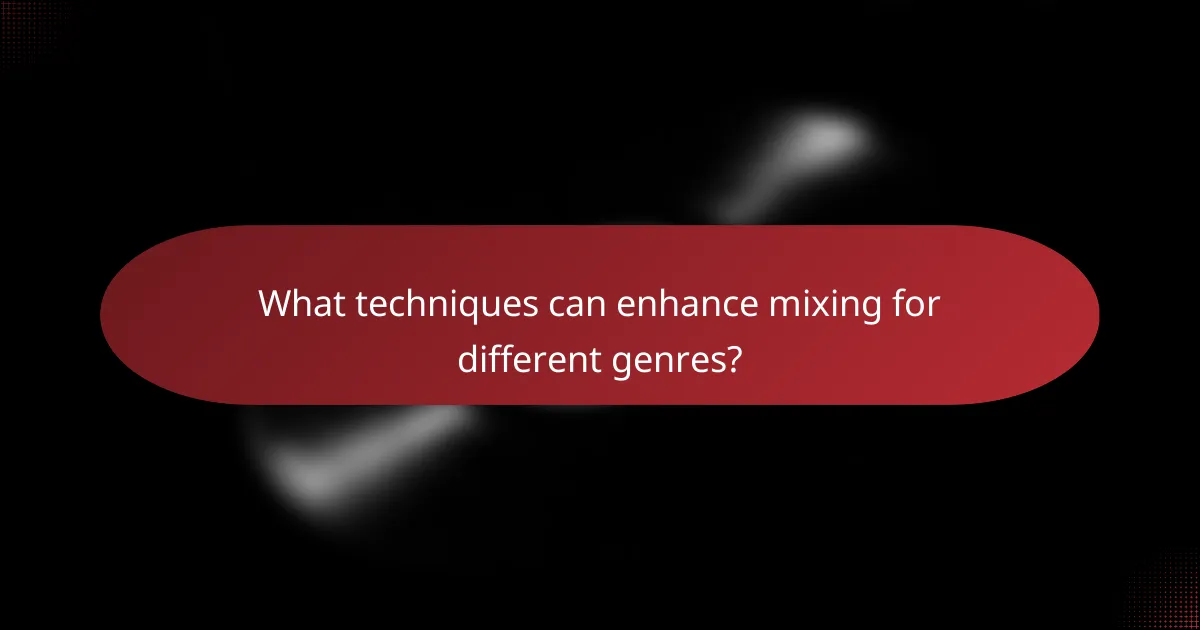
What techniques can enhance mixing for different genres?
Techniques that enhance mixing for different genres include layering instruments, applying genre-specific EQ settings, and using dynamic range compression. These methods help achieve a sound that aligns with the characteristics of each genre while maintaining clarity and balance in the mix.
Layering instruments for genre blending
Layering instruments involves combining multiple sounds to create a richer texture that suits various genres. For example, in pop music, you might layer synths with acoustic guitars to achieve a fuller sound. Consider using different octaves or timbres to enhance the blend without overcrowding the mix.
When layering, ensure that each element has its own space in the frequency spectrum. This can be achieved by panning instruments left or right and adjusting their volume levels to prevent any one element from dominating the mix.
Using genre-specific EQ settings
Applying genre-specific EQ settings is crucial for achieving the desired tonal balance in a mix. For instance, electronic genres often benefit from boosted low frequencies, while acoustic genres may require a more balanced approach across the spectrum. Understanding the typical frequency ranges for each genre can guide your EQ adjustments.
A common practice is to use high-pass filters to remove unnecessary low-end rumble from instruments that don’t need it, allowing the bass and kick drum to stand out. Aim for clarity by cutting frequencies that muddy the mix, typically around 200-400 Hz.
Applying dynamic range compression
Dynamic range compression helps control the volume levels of different elements in a mix, making it essential for various genres. For example, rock music often uses compression to add punch to drums and guitars, while softer genres like folk may require gentler compression to maintain dynamics. Adjust the attack and release settings based on the genre’s energy level.
Be cautious not to over-compress, as this can lead to a lifeless sound. A good rule of thumb is to aim for a gain reduction of around 3-6 dB for most instruments, allowing for peaks without sacrificing overall dynamics.
Incorporating effects like reverb and delay
Reverb and delay are key effects that can enhance the spatial quality of a mix, tailored to fit different genres. For instance, lush reverb is often used in ballads to create an emotional atmosphere, while tighter delays may suit electronic or hip-hop tracks for rhythmic emphasis. Choose the effect type based on the genre’s characteristics.
When applying these effects, consider the mix’s overall depth and clarity. Use shorter reverb times for faster tempos and longer for slower pieces, and always check how these effects interact with other elements in the mix to avoid overwhelming the sound.
Utilizing automation for genre transitions
Automation allows for dynamic changes in volume, effects, and panning throughout a track, making it a powerful tool for genre transitions. For example, you might automate a synth’s filter cutoff to create a build-up in an electronic track or gradually increase the reverb on vocals during a chorus in a pop song. This technique can enhance the emotional impact of a song.
To effectively use automation, plan your transitions ahead of time and listen critically to ensure they feel natural. Avoid abrupt changes that can disrupt the flow unless they serve a specific artistic purpose, such as a dramatic drop in electronic music.
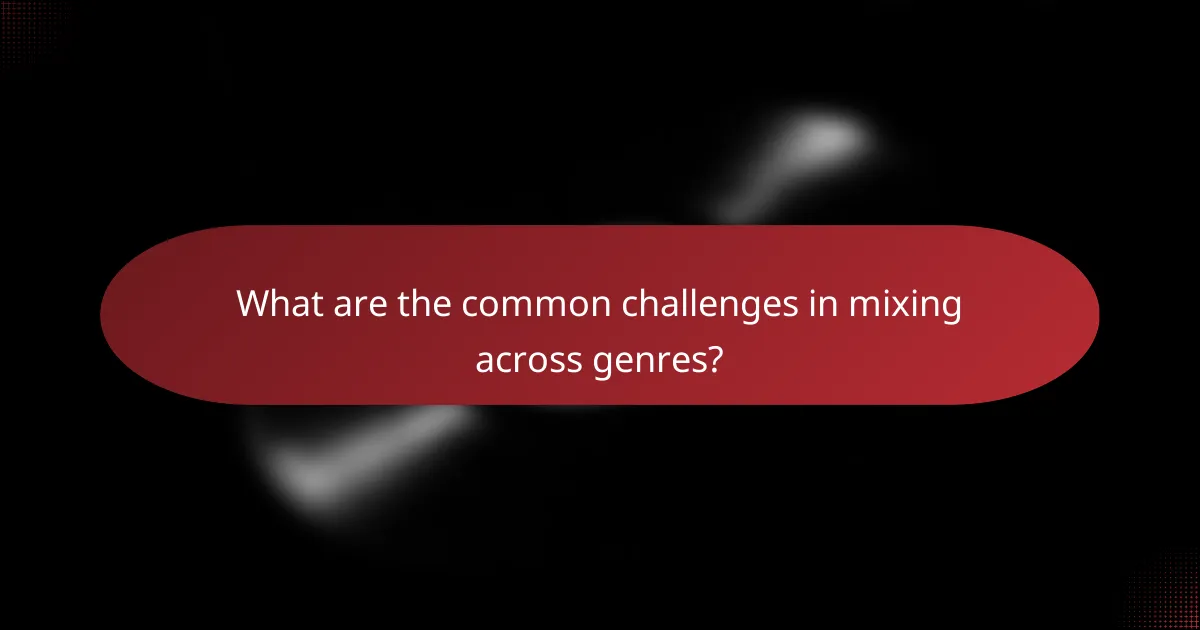
What are the common challenges in mixing across genres?
Mixing across genres presents unique challenges, primarily due to the differing sonic characteristics and expectations inherent in each style. Understanding these challenges can help producers and engineers create cohesive mixes that respect the essence of each genre while achieving a balanced sound.
Balancing diverse sonic elements
Each genre typically features distinct sonic elements, such as instrumentation, vocal styles, and production techniques. Balancing these elements requires careful attention to how they interact within the mix. For example, a rock track may have prominent guitars and drums, while a hip-hop track might focus on bass and rhythm, necessitating different approaches to achieve harmony.
To effectively balance these diverse elements, consider using frequency analysis tools to identify overlaps and gaps. Aim for clarity by ensuring that each instrument occupies its own sonic space, which may involve EQ adjustments and panning strategies.
Maintaining genre authenticity
Maintaining genre authenticity is crucial when mixing across styles, as listeners often have specific expectations based on the genre. This can involve adhering to traditional production techniques or using genre-specific sounds and effects. For instance, a pop mix might require polished vocals and bright synths, while a jazz mix may emphasize live instrumentation and natural reverb.
To preserve authenticity, research the conventions of each genre you’re mixing. Listening to reference tracks can provide insights into the expected sound and help guide your mixing decisions.
Dealing with conflicting frequencies
Conflicting frequencies often arise when instruments from different genres overlap in the same frequency range, leading to muddiness or masking. This is particularly common when mixing bass-heavy genres like EDM with more melodic styles like folk. Identifying and addressing these conflicts is essential for a clean mix.
Utilize EQ to carve out space for each element. For example, if a kick drum and bass guitar are competing, you might reduce the low frequencies of the bass slightly to allow the kick to punch through. Regularly check your mix in mono to ensure that elements remain clear and distinct.
Adapting to varying dynamic ranges
Different genres often have varying dynamic ranges, which can complicate the mixing process. For instance, classical music typically features a wide dynamic range, while pop music often employs compression to achieve a more consistent level. Understanding these differences is key to achieving a balanced mix.
When mixing across genres, consider using dynamic processing tools like compressors and limiters to manage levels effectively. Aim for a dynamic range that feels appropriate for the genre you’re working with, while also ensuring that quieter elements are audible without overpowering louder ones.
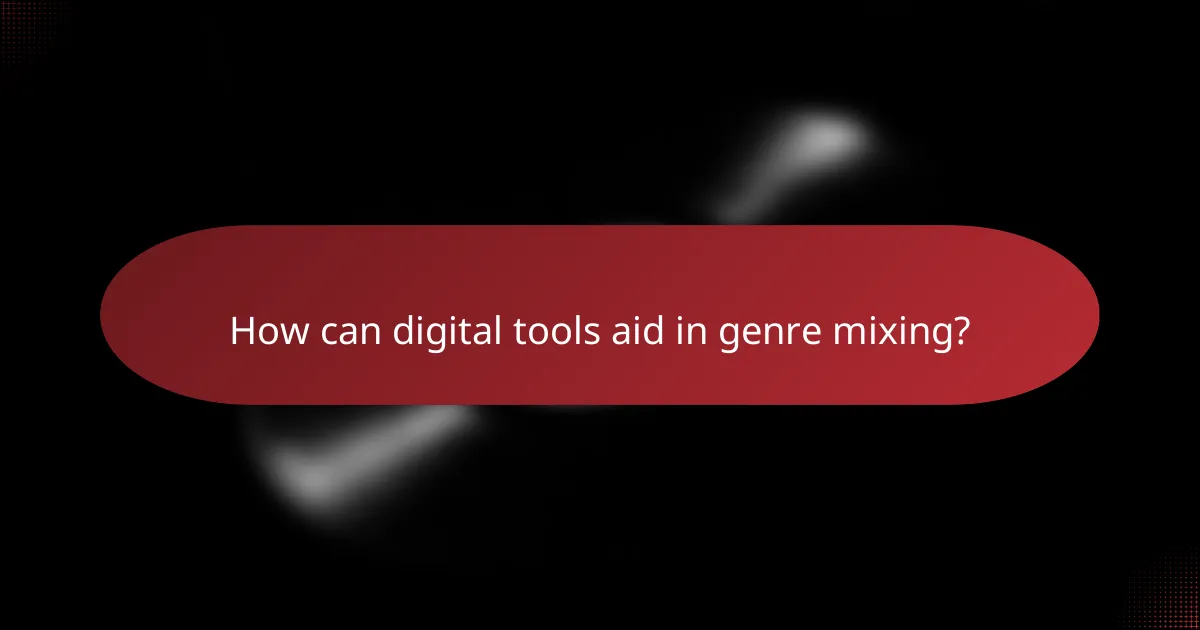
How can digital tools aid in genre mixing?
Digital tools significantly enhance genre mixing by providing musicians with versatile platforms to experiment with sounds and styles. These tools enable seamless integration of various elements, allowing for creative exploration and innovation in music production.
Using DAWs like Ableton Live for flexibility
Digital Audio Workstations (DAWs) like Ableton Live offer unparalleled flexibility for genre mixing. They allow users to manipulate audio tracks in real-time, facilitating the blending of different musical styles without the constraints of traditional recording methods.
With features such as clip launching and MIDI sequencing, producers can easily experiment with genre fusions. For instance, layering a hip-hop beat with jazz instrumentation can be accomplished effortlessly, encouraging creativity and spontaneity.
Employing plugins for genre-specific effects
Plugins are essential for adding genre-specific effects that enhance the overall sound of mixed genres. From vintage analog emulations to modern digital processors, these tools can shape the audio to fit specific styles, such as adding reverb for ambient music or distortion for rock.
Choosing the right plugins can significantly impact the mixing process. For example, using a compressor tailored for electronic music can help achieve punchy beats, while a warmer, tube-style compressor may suit acoustic genres better.
Leveraging sample libraries for authenticity
Sample libraries provide a vast array of authentic sounds that can enrich genre mixing. By incorporating high-quality samples from various genres, producers can create a more genuine blend, whether it’s integrating orchestral strings into a pop track or using traditional folk instruments in electronic music.
When selecting samples, consider the source and quality. Opting for professionally recorded libraries ensures that the sounds are polished and suitable for mixing. Additionally, using royalty-free samples can help avoid legal issues while maintaining creative freedom.

What are best practices for mixing across genres?
Best practices for mixing across genres involve understanding the unique characteristics of each genre and applying techniques that enhance their strengths. This requires a balance of creativity and technical skill to ensure that the final mix resonates with the intended audience while maintaining clarity and coherence.
Establishing a clear vision for the mix
Establishing a clear vision is crucial for successful mixing across genres. This involves defining the overall sound and emotional impact you want to achieve, which can guide your decisions throughout the mixing process. Consider creating a reference track from the target genre to help maintain focus.
Document your vision by outlining key elements such as instrumentation, vocal style, and dynamic range. This will serve as a roadmap during mixing, ensuring that you stay aligned with your goals and avoid unnecessary deviations.
Collaborating with genre experts
Collaborating with experts from the specific genres you are mixing can provide invaluable insights. These individuals can offer feedback on genre-specific techniques, instrumentation, and production styles that may not be familiar to you. This collaboration can lead to a more authentic sound that resonates with fans of that genre.
Consider setting up sessions with musicians or producers who specialize in the genres you are working with. Their expertise can help you navigate potential pitfalls and refine your mix to better suit the expectations of the genre’s audience.
Iterating through feedback loops
Iterating through feedback loops is essential for refining your mix across genres. After an initial mix, gather feedback from trusted peers or genre experts to identify areas for improvement. This process can reveal blind spots and provide fresh perspectives on your work.
Implement a structured feedback process by scheduling listening sessions and asking specific questions about the mix. Aim for multiple iterations, making adjustments based on the feedback received, which can significantly enhance the final product.

What criteria should be considered when selecting mixing techniques?
When selecting mixing techniques, consider genre characteristics, target audience preferences, and the intended emotional impact of the music. These criteria help ensure that the final mix aligns with listener expectations and effectively conveys the desired message.
Understanding genre characteristics
Each music genre has distinct characteristics that influence mixing techniques. For example, electronic music often requires precise control over bass frequencies, while acoustic genres may prioritize natural sound and dynamic range. Familiarity with genre conventions allows mixers to make informed decisions that resonate with listeners.
Additionally, different genres may have specific standards for loudness and clarity. For instance, pop music typically aims for a polished, radio-ready sound, while indie genres might embrace a more raw and organic feel. Understanding these nuances is crucial for achieving the right mix.
Assessing target audience preferences
Knowing your target audience is vital when selecting mixing techniques. Different demographics may have varying preferences for sound quality, instrumentation, and overall style. For example, younger audiences might favor heavily processed vocals and energetic beats, while older listeners may appreciate more traditional arrangements.
Engaging with your audience through surveys or social media can provide insights into their preferences. Tailoring your mix to meet these expectations can enhance listener satisfaction and increase the likelihood of commercial success.
Evaluating the intended emotional impact
The emotional impact of a mix is crucial for connecting with listeners. Consider what feelings you want to evoke and choose mixing techniques that support this goal. For instance, a ballad may benefit from a warm, intimate mix, while an upbeat track might require a more energetic and bright sound.
Utilizing techniques such as reverb and panning can help create a specific atmosphere. For example, using a wide stereo image can enhance feelings of openness and freedom, while tighter mixes may convey intimacy. Always align your mixing choices with the emotional narrative of the song to maximize its impact.






